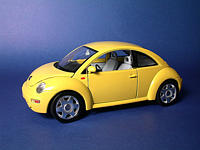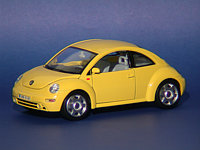The on-camera zoom lens is controlled by the zooming buttons in the upper right corner of the camera back panel:

Buttons W and T are for zooming out and zooming in, respectively. More precisely, press and hold the W (resp., T) button to make the focal length shorter (resp., longer). Keep in mind that a shorter (resp., longer) focal length covers a wider (resp., narrower) view. As the focal length is being adjusted by the zooming buttons, the LCD monitor displays a scale as shown below. This scale indicates the relative position of the current focal length.

Using the formula on the Overview page, we can compute the 5700 focal lengths that are approximately equal to commonly used 35mm focal lengths as follows:
| 35mm Focal Length | 35mm | 50mm | 85mm | 100mm | 135mm | 180mm | 200mm | 280mm |
| 5700 Focal Length | 8.9mm | 12.7mm | 21.6mm | 25.4mm | 34.3mm | 45.8mm | 50.9mm | 71.2mm |
Unfortunately, the 5700 design does not allow us to precisely control the process of focal length selection because the W and T buttons do not permit very fine adjustment. Worse, the zoom scale does not change in a linear way according to focal length change. From the following table, it is not difficult to see that the zoom scale has a finer increment in the wide angle end, and there is not much difference in the telephoto end, especially above 180mm. Consequently, do not rely on the zoom scale to judge what focal length is being used. Note that the focal length marks on a SLR lens do not change in a linear way either; but, there are marks on the manual zoom ring. Thus, it is easier to determine the focal length being used.
| 35mm Focal Length | 5700 Focal Length | What You Can Get | Zoom Scale |
| 35mm | 8.9mm | 8.9mm | 
|
| 50mm | 12.7mm | 12.7mm | 
|
| 85mm | 21.6mm | 22.3mm | 
|
| 100mm | 25.4mm | 25.4mm | 
|
| 135mm | 34.3mm | 34.7mm | 
|
| 180mm | 45.8mm | 44.7mm | 
|
| 200mm | 50.9mm | 48.5mm | 
|
| 280mm | 71.2mm | 71.2mm | 
|
What if you really need to precisely set the focal length? I am not aware of any easy way. The above zoom scales were shot by trial and error. In other words, the lens was zoomed to a position, took a shot, review the image data, readjust the lens, and repeat until the indicated focal length is approximately equal to what you need.
When you have a powerful zoom lens like the on-camera one, you might ask a very simple and yet important question: Which focal length should I use? The answer to this question boils down to the concepts of angle of view and perspective. You can use almost all available focal lengths to photo the same scene as long as you have space for you to maneuver. That is, if you are willing to move your position, the same scene can be taken with virtually all available focal lengths. The choice of focal length depends on the perspective you want.
Recall that angle of view of a lens is determined by its focal length and the image size. The following table, taken from the Overview page, lists a number of angle of view for some popular focal lengths.
| 5700 | 35mm | Angle of View (degree) |
| 4.3mm | 17mm | 104 |
| 5.1mm | 20mm | 94 |
| 6.1mm | 24mm | 84 |
| 7.1mm | 28mm | 75 |
| 8.9mm | 35mm | 63 |
| 12.7mm | 50mm | 47 |
| 21.6mm | 85mm | 29 |
| 25.4mm | 100mm | 24 |
| 34.3mm | 135mm | 18 |
| 50.9mm | 200mm | 12 |
| 76.3mm | 300mm | 8 |
| 101.7mm | 400mm | 6 |
From this table we know that telephoto lenses have narrower angles of view than wide angle lenses. Suppose we want to take a photo of the three yellow objects as shown below. The left figure uses a telephoto lens, while the right one uses a wide angle lens. Because a telephoto lens has a narrower angle of view than a wide angle lens, to cover all three yellow objects, the camera-subject distance is longer than that of a wide angle lens. Hence, the image taken using a telephoto lens will only include the two middle red objects, while the image taken using a wide angle lens may include all six!

Because the image size is the same for both lenses, we can anticipate that the three yellow objects in both images would have approximately the same size. On the image by the wide angle lens, because all six red objects are recorded, they will look smaller than the two red ones on the image by the telephoto lens. Consequently, we have an illusion that these six red objects are farther away from the camera. On the other hand, since the telephoto image includes less objects, the two red and three yellow objects look like packed tightly together. This is the effect of "compression." Hence, the image with a wide angle lens has a different perspective than the one taken with a telephoto lens.
The meaning of perspective is difficult to be defined precisely. Because the image of a three-dimensional scene is two-dimensional, perspective is created by the relative size of similar objects (i.e., a distant object looks smaller than a nearby similar object), converging lines, and so on.
Normally, we use telephoto lenses to take images of distant subjects so that the desired portion of the scene is "extracted" from its surrounding environment. The distance between two objects looks shorter and hence the scene seems "compressed" (i.e., objects look like close to each other). On the other hand, wide angle lenses are normally used to take wide area and "exaggerate" the nearby objects (i.e., they look like larger than their actual sizes). The following images show this effect. In the image taken with 24mm, the front left portion of the model car is exaggerated. When this model car is retaken using 35mm and maintaining the same size (on the image) and orientation, the exaggeration reduces. Then, we retake the same model car at 50mm. Now it looks normal (i.e., similar to what our eyes see). The images taken with 100mm and 150mm look very similar without exaggeration, and this is why moderate telephoto lenses with focal length in the range of 80mm and 135mm are normally used for portraiture work for less perspective distortion. Then, we use 200mm, 300mm, 450mm and finally 1200mm. Those images taken with long focal lengths all show the compression effect.

|

|

|
| 24mm | 35mm | 50mm |

|

|

|
| 100mm | 150mm | 200mm |

|

|

|
| 300mm | 450mm | 1200mm |
| Click on the image to see a larger one | ||
There are more information in the Converter Lenses section, including a focal length comparison, lens hoods, and the discussion of each of the five converters.
Similar to virtually all consumer level digital cameras, the 5700 has a vari-focal zoom lens. A vari-focal zoom lens is a zoom lens that does not keep the lens focused while zooming. In other words, if we focus the lens at a point and zoom the lens, we must refocus. This is in general not a problem with a auto focus camera; however, it will make manual focus a little tedious because we need to take care of both zooming and focusing!